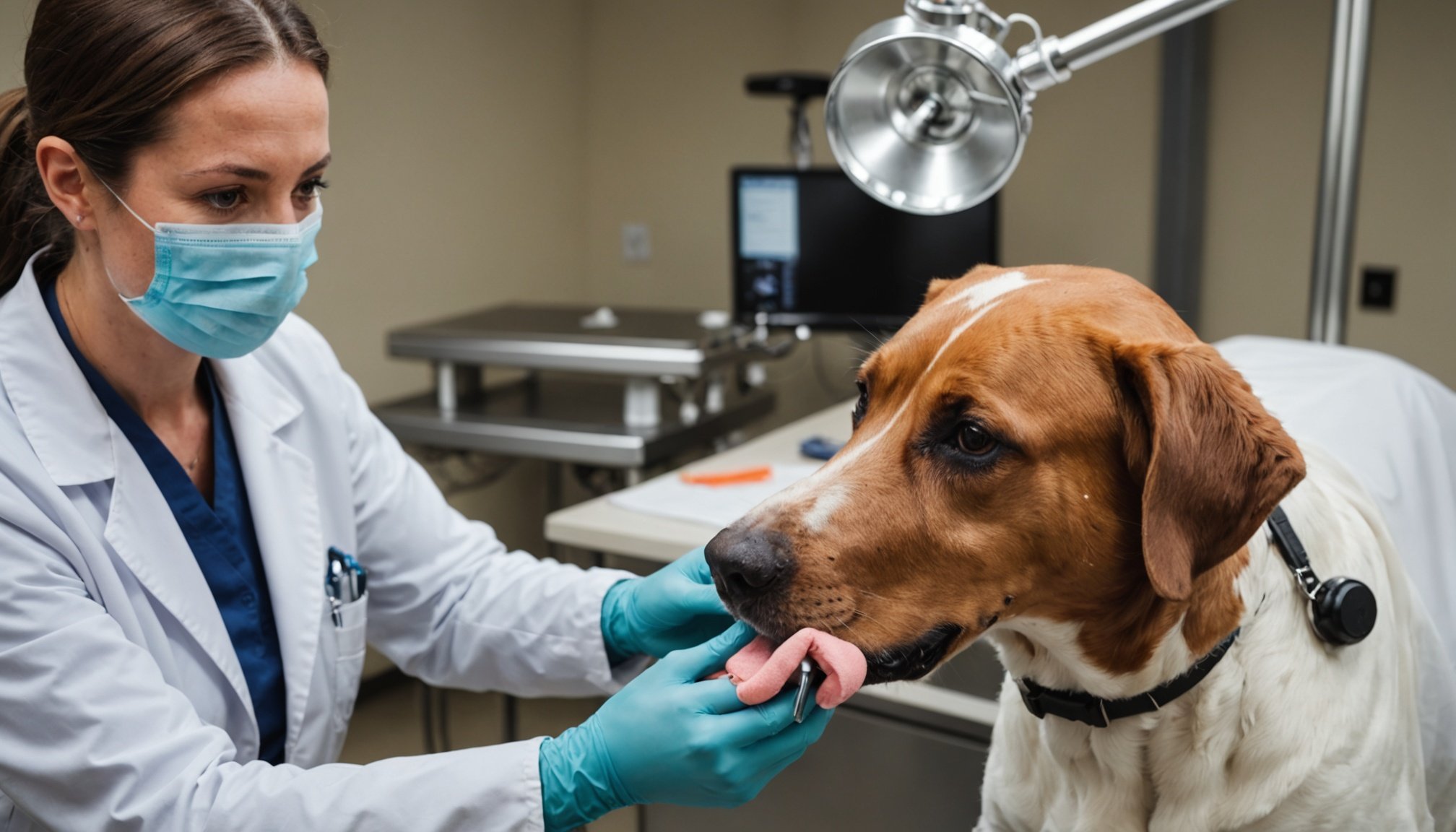Essential Strategies for UK Veterinary Surgeons to Reduce Animal Stress During Procedures
When it comes to veterinary care, one of the most critical aspects is ensuring the welfare and comfort of the animals. Reducing stress during veterinary procedures is not only ethical but also crucial for the health and well-being of the animals. Here, we will delve into the essential strategies that UK veterinary surgeons can employ to minimize animal stress.
Understanding Animal Stress
Before we dive into the strategies, it’s important to understand what stress means for animals. Stress in animals, particularly dogs and cats, can manifest in various ways, including changes in behavior, body language, and physiological responses.
In parallel : Essential Travel Health Tips: Preventive Strategies from UK Infectious Disease Experts for Safer Journeys
Recognizing Stress Signals
- Body Language: Animals often display specific body language cues when stressed, such as tail tucking, ear flattening, or avoidance behaviors.
- Vocalization: Increased barking, meowing, or other vocalizations can indicate anxiety.
- Physiological Changes: Rapid breathing, increased heart rate, and sweating (in dogs) are physical signs of stress.
“Recognizing these signals is the first step in managing stress. By understanding that a dog’s tucked tail or a cat’s flattened ears are signs of stress, veterinarians can take proactive steps to alleviate it,” notes Dr. Caitlin McCafferty, a veterinary professional with extensive experience in animal behavior.
Pre-Procedure Preparation
Preparation is key to reducing stress during veterinary procedures. Here are some strategies that can be implemented:
Have you seen this : Exploring Cutting-Edge Strategies UK Allergists Employ for Treating Adult-Onset Asthma
Training and Socialization
- Gradual Exposure: Gradually exposing animals to the veterinary environment through positive reinforcement can help reduce anxiety. This includes visits to the vet clinic without procedures, treats, and positive interactions.
- Desensitization: Desensitizing animals to the sights, sounds, and smells of the veterinary clinic can help them feel more comfortable.
“Training and socialization are crucial. By making the veterinary clinic a positive place for animals, we can significantly reduce their stress levels,” advises Dr. McCafferty.
Client Education
- Informing Owners: Educating pet owners on how to prepare their animals for visits, such as feeding schedules and pre-visit calming techniques, can make a big difference.
- Pre-Visit Calming Aids: Recommending calming aids like pheromone diffusers, calming treats, or anti-anxiety medications (if necessary) can help reduce stress before the visit.
In-Clinic Strategies
Once the animal is at the clinic, several strategies can be employed to minimize stress:
Minimizing Waiting Times
- Efficient Scheduling: Ensuring that appointments are scheduled efficiently to minimize waiting times can reduce anxiety.
- Comfortable Waiting Areas: Providing comfortable, quiet waiting areas can help animals feel more at ease.
Calming Environments
- Calming Music and Lighting: Using calming music and soft lighting can create a more relaxing atmosphere.
- Pheromone Therapy: Using synthetic pheromones like Feliway for cats and Adaptil for dogs can mimic natural calming scents.
Gentle Handling
- Handling Techniques: Training veterinary staff in gentle, calm handling techniques is essential. This includes moving slowly, speaking softly, and avoiding sudden movements.
- Supportive Restraint: Using supportive restraint methods that are comfortable and secure can help reduce stress during procedures.
Communication with Clients
Effective communication with pet owners is vital in managing animal stress.
Explaining Procedures
- Clear Communication: Clearly explaining the procedures to the owners and ensuring they understand what will happen can help alleviate their anxiety, which in turn can calm the animal.
- Reassurance: Providing reassurance and support to the owners can help them stay calm, which can positively impact the animal’s stress levels.
Involving Owners
- Owner Presence: Allowing owners to be present during procedures, if possible, can provide comfort to the animal.
- Owner Feedback: Encouraging owners to provide feedback on their animal’s behavior and stress signals can help tailor the approach to the individual animal’s needs.
Post-Procedure Care
After the procedure, ensuring the animal’s comfort and reducing stress is just as important.
Pain Management
- Effective Pain Relief: Ensuring that animals receive adequate pain relief can significantly reduce stress and discomfort post-procedure.
- Monitoring: Close monitoring of the animal’s condition post-procedure to address any signs of stress or discomfort promptly.
Discharge Instructions
- Clear Instructions: Providing clear discharge instructions to owners, including how to manage pain and monitor for signs of stress, is crucial.
- Follow-Up: Scheduling follow-up appointments to check on the animal’s recovery and address any concerns can help ensure the animal’s welfare.
Practical Insights and Actionable Advice
Here are some practical insights and actionable advice for veterinary surgeons:
Use of Alternative Therapies
- Alternative Therapies: Considering alternative therapies such as physiotherapy, hydrotherapy, or acupuncture can provide additional comfort and stress relief for animals.
Mental Health of Veterinarians
- Veterinarian Well-being: It’s also important to note that the mental health of veterinarians themselves can impact their ability to manage animal stress. Ensuring financial security and providing support for mental health can be crucial.
Detailed Strategies for Common Procedures
Here are some detailed strategies for common veterinary procedures:
Vaccinations
- Gradual Introduction: Gradually introducing the animal to the vaccination process, starting with small steps like simply entering the examination room.
- Positive Reinforcement: Using positive reinforcement techniques such as treats and praise during and after the vaccination.
Dental Procedures
- Pre-Procedure Sedation: Considering pre-procedure sedation to reduce anxiety and stress during dental procedures.
- Gentle Handling: Ensuring that the animal is handled gently and carefully during the procedure.
Surgical Procedures
- Pre-Surgical Preparation: Preparing the animal thoroughly before surgery, including fasting instructions and pre-anesthetic medications to reduce stress.
- Post-Surgical Care: Providing comprehensive post-surgical care instructions to owners and ensuring adequate pain relief.
Table: Comparison of Stress Reduction Strategies
| Strategy | Description | Benefits | Challenges |
|---|---|---|---|
| Training and Socialization | Gradual exposure to the veterinary environment | Reduces anxiety, makes visits more positive | Requires time and effort from owners |
| Client Education | Informing owners on preparation and calming aids | Helps owners prepare animals effectively | Requires clear communication from veterinarians |
| Minimizing Waiting Times | Efficient scheduling and comfortable waiting areas | Reduces anxiety and stress | Requires good clinic management |
| Calming Environments | Use of calming music, lighting, and pheromones | Creates a relaxing atmosphere | May require additional resources |
| Gentle Handling | Training staff in gentle handling techniques | Reduces stress during procedures | Requires ongoing training and practice |
| Communication with Clients | Clear explanation of procedures and involving owners | Helps owners and animals feel more at ease | Requires effective communication skills |
| Post-Procedure Care | Effective pain relief and monitoring | Ensures animal comfort post-procedure | Requires close monitoring and follow-up |
Quotes from Experts
- “The key to reducing animal stress is a multi-faceted approach that includes preparation, a calming environment, gentle handling, and effective communication with clients,” says Dr. McCafferty.
- “Burnout among veterinarians is a significant issue, and addressing it is crucial for maintaining the mental health and well-being of both veterinarians and the animals they care for”.
Reducing animal stress during veterinary procedures is a complex but achievable goal. By implementing strategies such as training and socialization, creating calming environments, using gentle handling techniques, and ensuring effective communication with clients, veterinary surgeons can significantly improve the welfare of the animals in their care. Remember, every small step counts, and a holistic approach that considers the entire experience from pre-procedure to post-procedure care is essential for minimizing stress and ensuring the best possible outcomes for animals.
In the words of Dr. McCafferty, “By prioritizing animal welfare and taking proactive steps to reduce stress, we not only improve the health and well-being of our patients but also enhance the overall quality of veterinary care.”











